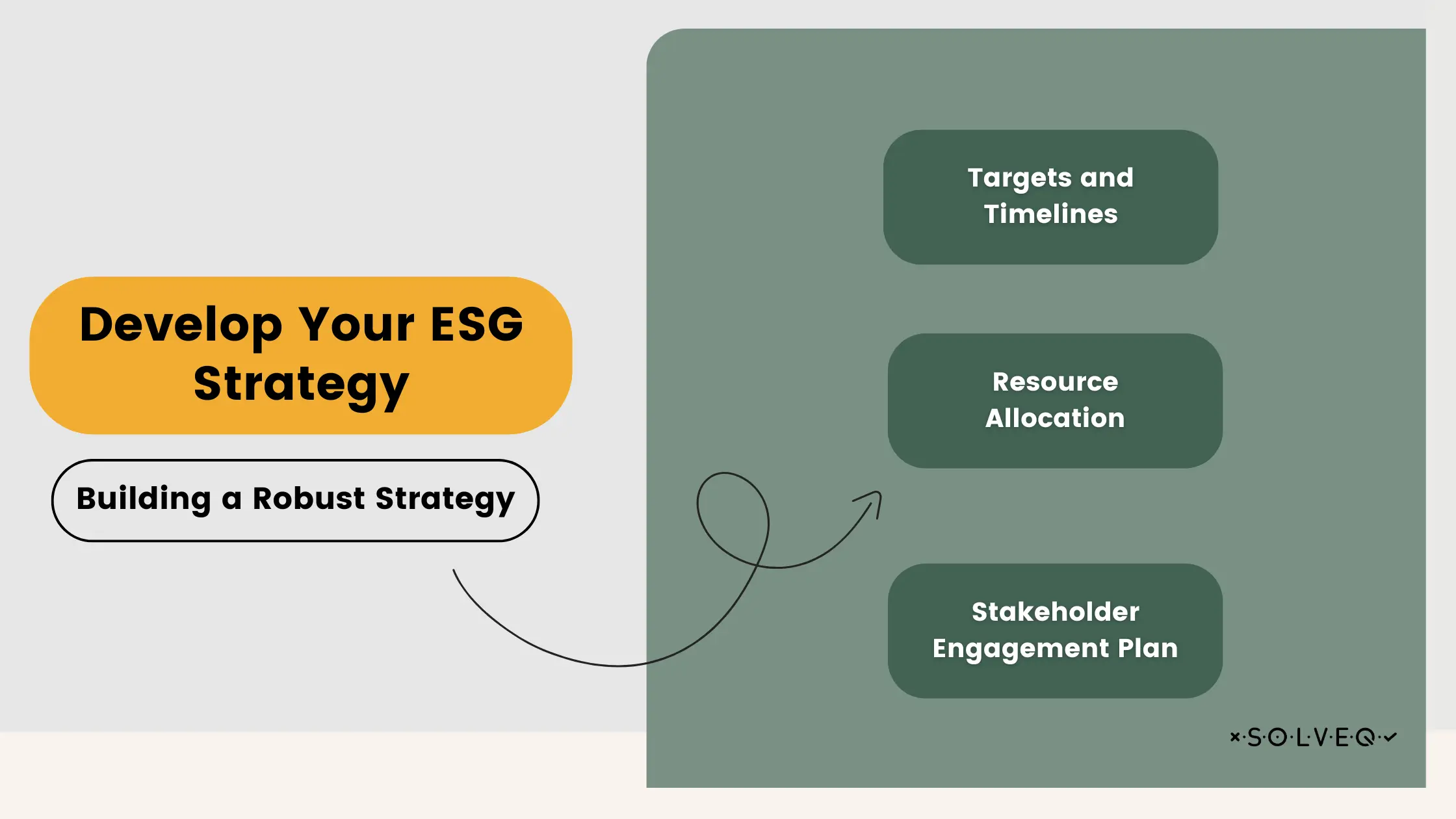How to Get Started with ESG: A Roadmap for Companies
30 Apr 2024 • 11 min read

Marcin Kulawik

Once dismissed as a mere buzzword, ESG (Environmental, Social, and Governance) is now a critical topic for businesses of all sizes. With new reporting regulations coming into effect next year, companies face a crucial deadline to demonstrate their ESG impact. A well-designed roadmap can simplify this process, empowering your business to embark on a successful and compliant ESG journey.
Assess Your Current Position
Faced with the prospect of ESG reporting for the first time, it's easy to feel overwhelmed. To make it manageable, it best to break it down into smaller steps. The first crucial move is understanding your company's current ESG performance. This provides several benefits:

- Credibility and Transparency: Having a clear picture of your current ESG performance allows for transparent reporting, which builds trust with stakeholders.
- Targeted Improvements: Identifying existing strengths and weaknesses helps you prioritize areas for improvement and maximize the impact of your ESG efforts.
- Benchmarking: Knowing your baseline allows you to track progress over time and benchmark your performance against industry standards.
Building Your ESG Team
There are two main ways to assess your current position:
- Internal Team: Assemble a dedicated in-house team of experts. Considering the ongoing nature of ESG reporting (annual reporting will likely become the norm), this team will have a continuous workload.
- Consultants: Partner with an external consulting company specializing in ESG.
Utilizing Frameworks and Tools
Regardless of the team approach you choose, it's crucial to utilize a well-established reporting framework or a specialized ESG assessment tool. Many organizations offer free or paid self-assessment tools tailored to specific industries. These tools typically ask questions concerning your environmental practices, social responsibility, and governance structures.
On the other hand Global Reporting Initiative (GRI) Standards Framework provides a comprehensive framework for sustainability reporting. This framework outlines key performance indicators (KPIs) for various ESG topics, allowing you to gauge your performance in each area.
All in all these resources provide a structured approach to gathering data and evaluating your company's performance.
Conduct a Materiality Assessment
Having a clear understanding of your current ESG performance is a great first step. But how do you prioritize the specific areas with the most impact on your business and stakeholders? This is where a materiality assessment comes in.
A materiality assessment is a process that identifies the most relevant ESG issues for your company. These issues are considered "material" because they have the greatest potential to affect your business financially, environmentally, and socially, and vice versa. By focusing on these high-impact areas, you can ensure your ESG efforts are most effective.
Identifying Industry-Specific and Business Model Factors:
To conduct a successful materiality assessment, consider these factors:
- Industry: Analyze the typical ESG challenges and opportunities within your industry. For example, a manufacturing company would likely prioritize energy consumption and waste management, while a technology company might focus on data privacy and responsible sourcing of materials.
- Business Model: Evaluate how your specific business model interacts with ESG issues. Is your company heavily reliant on natural resources? Does your workforce face unique health and safety considerations? Understanding these connections allows you to pinpoint the most material ESG topics for your company.
Common Materiality Topics:
While the specific material issues will vary by company, some common themes often emerge in ESG reporting:
- Environmental: Climate change, resource use (water, energy), waste management, pollution control.
- Social: Employee well-being, diversity and inclusion, labor practices, community engagement.
- Governance: Ethics and compliance, board diversity, risk management, transparency.

Set Ambitious Yet Realistic Goals
With your materiality assessment complete, it's time to chart your course by setting ambitious yet realistic ESG goals. These goals should be directly linked to the most relevant ESG issues identified in step 2 and clearly aligned with your company's core values.
Aligning Goals with Values and Materiality
- Values-driven Goals: The most impactful ESG goals resonate with your company's core values. By focusing on areas where your values intersect with material issues, you can create a sense of purpose and ownership within your organization.
- Materiality as a Guide: Use the results of your materiality assessment as a roadmap. Prioritize setting goals that address the issues most significant to your business and stakeholders.
Finding the Goal-Setting Sweet Spot
- Reaching for More: While your goals should be achievable, aiming for ambition can spark innovation and drive meaningful progress. Strive for goals that push your company beyond the status quo but remain grounded in feasibility.
- Recognized Frameworks: Utilize established ESG frameworks like the Global Reporting Initiative (GRI) or the Sustainability Accounting Standards Board (SASB) as a resource. These frameworks offer industry-specific guidance on goal setting and best practices.
Striking the Balance
The ideal ESG goal setting process finds a balance between aspiration and attainability. Reaching for ambitious targets while considering your resources and current performance ensures your goals are both motivating and achievable. Remember, successful ESG programs are built on incremental progress over time.
Develop Your ESG Strategy
Now that you've assessed your current position and identified your most material ESG issues, it's time to craft a strategic roadmap for improvement. A strong ESG strategy should be a well-defined plan that integrates with your overall business strategy. Here are the key components to consider:
Building a Robust Strategy

- Targets and Timelines: Set measurable and ambitious, yet achievable, goals (targets) for each material ESG issue. These targets should come with clear deadlines (timelines) to track progress and ensure accountability.
- Resource Allocation: Identify the resources (financial, human, technological) needed to achieve your ESG goals. Allocate these resources strategically to ensure effective execution of your initiatives.
- Stakeholder Engagement Plan: Develop a comprehensive plan to engage with your stakeholders (investors, employees, customers, communities) on your ESG efforts. Transparency and open communication are key to building trust and securing support.
Breaking it Down
Developing your ESG strategy can be broken down into these manageable steps:
- Brainstorming & Prioritization: Gather input from various departments and stakeholders to identify potential ESG initiatives that address your material issues. Prioritize these initiatives based on their impact and feasibility.
- Goal Setting: Based on your prioritized initiatives, establish specific, measurable, achievable, relevant, and time-bound (SMART) goals (targets) with clear deadlines (timelines).
- Action Planning: Develop detailed action plans for each initiative, outlining the specific steps, resources required, and responsible parties for implementation.
Alignment with Business Strategy
Remember, your ESG strategy should not exist in isolation. Ensure strong alignment with your overall business strategy. By demonstrating how ESG initiatives contribute to long-term business success, you can secure greater buy-in and commitment from leadership and employees alike.
A well-crafted ESG strategy, coupled with a commitment to continuous improvement, will empower your company to navigate the evolving ESG landscape and build a more sustainable future.
Options and Standardization
There are various options for reporting your ESG progress. Many companies utilize the Global Reporting Initiative (GRI) Standards, which provide a comprehensive framework for sustainability reporting. These standards offer guidance on data collection, disclosure, and best practices.
The landscape of ESG reporting is constantly evolving, with a growing emphasis on standardization. Regulatory requirements like the upcoming Corporate Sustainability Reporting Directive (CSRD) in the EU are pushing for more consistent and comparable reporting formats.

Internal and External Communication
Don't limit your communication efforts to formal reports. Here's how to effectively share your ESG progress internally and externally:
- Internal Communication: Keep employees informed through company newsletters, town halls, and training sessions. Engaged employees are essential for successful ESG implementation.
- External Communication: Utilize your website, social media channels, and press releases to share your ESG journey with investors, customers, and the public. Highlighting achievements and challenges fosters transparency and builds trust.
By proactively communicating your ESG efforts, you can gain valuable feedback from stakeholders, strengthen your brand reputation, and attract investors increasingly focused on sustainable practices. Remember, a successful ESG strategy is a continuous journey, and ongoing communication is essential for demonstrating your commitment and achieving long-term impact.
Summary
In light of new ESG regulations with looming deadlines, no company can afford to ignore this topic. The best approach is to be prepared beforehand, minimizing errors and avoiding a year-end crunch.
To make things easier, we've broken down the entire process into smaller, achievable steps. This creates a clear roadmap, offering a great starting point for many companies.
Armed with the information from this article, you can approach this task with a strong understanding and a relaxed mindset. Once you assess your current and future ESG needs, consider consulting with experts to determine the best approach for your business.
Here at SolveQ, our team of experts can provide you with more detailed guidance and create a customized solution to help you execute your reports smoothly and with less hassle.
Share:
Looking for expert development team?
Schedule a call with Tech Consultant

Marcin Kulawik
Founder and CEO of SolveQ. Huge fan of building things with purpose, agility, and having fun while changing the World. Loves his family, teammates, and nature.